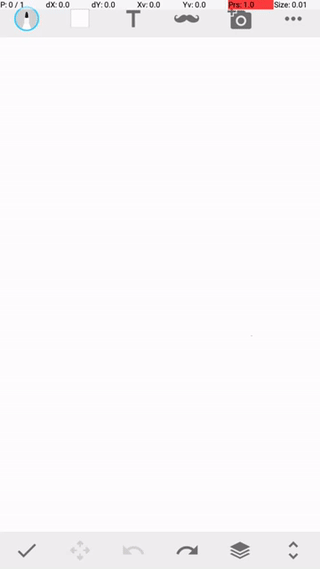_ _ _ _ _
__ _ _ __ __| |_ __ ___ (_) __| | | |_ ___ _ _ ___| |__
/ _` | '_ \ / _` | '__/ _ \| |/ _` | | __/ _ \| | | |/ __| '_ \
| (_| | | | | (_| | | | (_) | | (_| | | || (_) | |_| | (__| | | |
\__,_|_| |_|\__,_|_| \___/|_|\__,_| \__\___/ \__,_|\___|_| |_|
android_touch is a tool to send multitouch events to android device. Generally it is used by various automation scripts to send touch events on real android device.
android_touch is a dependency free native Android tool to send multitouch
inputs at very high speed with very low latency.
android_touch provides a http server for triggering multitouch events and gestures on Android devices. It works without root if started via ADB. Touch commands are sent to device as http request with JSON data.
Multitouch data is sent as JOSN which can contain any type of touch events such as taps or complex gestures.
Android touch is built upon libevdev to communicate with touch input device.
All prebuilt executable binaries for android_touch can be located in "libs" directory. You need to first determine what is your Android CPU Architecture, it can be one of the following :
- armeabi
- armeabi-v7a
- arm64-v8a
- x86
- x86_64
- mips
- mips64
After you have determined CPU Architecture, you need to push "libs/{CPU_ARCH}/touch" to devices "/data/local/tmp" directory.
For example if your CPU Architecture is "arm64-v8a" then run following command:
$ adb push libs/arm64-v8a/touch /data/local/tmpTo start android_touch http server on the android device run following command:
$ adb shell /data/loal/tmp/touchThis will start android_touch http server on port 9889
As the http server is running on Android device itself, to send request from your host machine, you need to forward port 9889 of android to any port on host machine. For example if you want to send http request on host machines 9889 port:
$ adb forward tcp:9889 tcp:9889Sending http request is straight forward, you can use any programming language and send http request to android_touch server. For example in python you can use urllib2 to send http request or on bash you can use curl tool to do the same.
Below is the example of sending a click touch event on coordinate 100x100 using curl tool:
$ curl -d '[{"type":"down", "contact":0, "x": 100, "y": 100, "pressure": 50}, {"type": "commit"}, {"type": "up", "contact": 0}, {"type": "commit"}]' http://localhost:9889android_touch allows you send a large set of touch commands to device in one shot. You can send individual touch commands by making separate http requests or can pack all touch commands and send in one shot. Sending all touch data in one shot will obviously reduce latency.
android_touch http server only accepts json array of command objects. Following are the list of touch commands:
| Command | Description | ||||||||
|---|---|---|---|---|---|---|---|---|---|
|
This sends a touch down event to android device for next commit, following are the required parameters
|
|||||||||
This sends a touch move event to android device for next commit, following are the required parameters
|
|||||||||
This sends a touch up event to android device for next commit, following are the required parameters
|
|||||||||
| This sends a commit command to the android device, until a commit command is sent, all previous changes to a touch contact using command such as down, up and move will not be visible on the device. Please also note that you can not have more than one down,move or up for the same contact in one commit. | |||||||||
This allows pauses between touch events, following are the required parameters
|
Following are some valid json objects of above commands:
| Command | Example Object |
|---|---|
| down | {"type": "down", "contact": 0, "x": 100, "y": 100, "pressure": 50} |
| move | {"type": "move", "contact": 0, "x": 200, "y": 200, "pressure": 50} |
| up | {"type": "up", "contact": 0} |
| commit | {"type": "commit"} |
| delay | {"type": "delay", "value": 500} |
Tap on coordinate 100x100 with 50 pressure
[
{"type": "down", "contact": 0, "x": 100, "y": 100, "pressure": 50},
{"type": "commit"},
{"type": "up", "contact": 0},
{"type": "commit"}
]Double tap on coordinate 100x100 with 50 pressure with 100ms delay between taps and release at same time.
[
{"type": "down", "contact": 0, "x": 100, "y": 100, "pressure": 50},
{"type": "commit"},
{"type": "up", "contact": 0},
{"type": "commit"},
{"type": "delay", "value": 100},
{"type": "down", "contact": 0, "x": 100, "y": 100, "pressure": 50},
{"type": "commit"},
{"type": "up", "contact": 0},
{"type": "commit"}
]Tap on two coordinates 100x100 and 200x200 simultaneously and release simultaneously after 100ms
[
{"type": "down", "contact": 0, "x": 100, "y": 100, "pressure": 50},
{"type": "down", "contact": 1, "x": 200, "y": 200, "pressure": 50},
{"type": "commit"},
{"type": "delay", "value": 100},
{"type": "up", "contact": 0},
{"type": "up", "contact": 1},
{"type": "commit"}
]Tap on two coordinates 100x100 and 200x200 simultaneously and release finger 1 after 100ms and finger 2 after 200ms
[
{"type": "down", "contact": 0, "x": 100, "y": 100, "pressure": 50},
{"type": "down", "contact": 1, "x": 200, "y": 200, "pressure": 50},
{"type": "commit"},
{"type": "delay", "value": 100},
{"type": "up", "contact": 0},
{"type": "commit"},
{"type": "delay", "value": 100},
{"type": "up", "contact": 1},
{"type": "commit"}
]Swipe between 100x100 and 400x100
[
{"type": "down", "contact": 0, "x": 100, "y": 100, "pressure": 50},
{"type": "commit"},
{"type": "move", "contact": 0, "x": 100, "y": 400, "pressure": 50},
{"type": "commit"},
{"type": "up", "contact": 0},
{"type": "commit"}
]Swipe gesture including points 100x100, 110x110, 120x130, 120x150
[
{"type": "down", "contact": 0, "x": 100, "y": 100, "pressure": 50},
{"type": "commit"},
{"type": "move", "contact": 0, "x": 110, "y": 110, "pressure": 50},
{"type": "commit"},
{"type": "move", "contact": 0, "x": 120, "y": 130, "pressure": 50},
{"type": "commit"},
{"type": "move", "contact": 0, "x": 120, "y": 150, "pressure": 50},
{"type": "commit"},
{"type": "up", "contact": 0},
{"type": "commit"}
]See example python script for complex gesture generation, which generates following gesture:
android_touch can be built for both linux and android platforms. Linux build can be done using cmake and make where Android build can be done using ndk-build.
Linux executable can be used with linux multitouch input device drivers wheres Android executable can be used on android devices which contains multitouch input touchscreen.
android_touch$ ndk-buildandroid_touch$ mkdir build
android_touch$ cd build
android_touch/build$ cmake ..
android_touch/build$ makeIf you are running on Android, then all verbose logs are dispatched to logcat, you can see internal working by:
$ adb logcat | grep touchFor example following is the debug output in logcat for below command:
$ curl -d '[{"type":"down", "contact":0, "x": 100, "y": 100, "pressure": 50}, {"type": "commit"}, {"type": "up", "contact": 0}, {"type": "commit"}]' http://localhost:9889android_touch: TouchInput : down : 0 : 100 : 100 : 50
android_touch: TouchInput : writeInputEvent : 3 : 47 : 0
android_touch: TouchInput : writeInputEvent : 3 : 57 : 1
android_touch: TouchInput : writeInputEvent : 3 : 48 : 6
android_touch: TouchInput : writeInputEvent : 3 : 50 : 4
android_touch: TouchInput : writeInputEvent : 3 : 53 : 100
android_touch: TouchInput : writeInputEvent : 3 : 54 : 100
android_touch: TouchInput : writeInputEvent : 0 : 0 : 0
android_touch: TouchInput : up : 0
android_touch: TouchInput : writeInputEvent : 3 : 47 : 0
android_touch: TouchInput : writeInputEvent : 3 : 57 : -1
android_touch: TouchInput : writeInputEvent : 0 : 0 : 0
Used internally by Bobble Keyboard for their keyboard automation.

